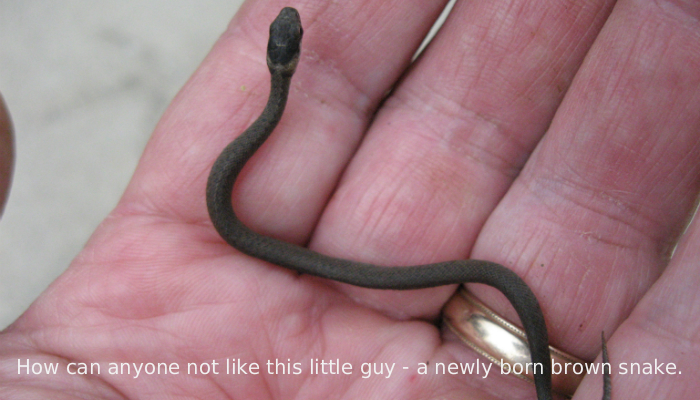Snakes, Security, and Common Sense

I was quite surprised when the large eastern Iowa senior high school that I attended was the focus of a newspaper article describing its security procedures. Students are now issued electronically coded, individual pass-cards to enter the otherwise locked school. Also, a uniformed officer from the municipal police force is stationed in the building during regular school hours. I take this as a troubling commentary on our post 9/11 preoccupation with security and changing societal mores. Danger, it seems, lurks everywhere today, even at a consistently top-ranked high school in Iowa. Or so we seem to have convinced ourselves. As I pondered on these revelations, I thought of the rich irony.
Biology and all manner of things plant or animal found in the out-of-doors were my great passion as a youth (and still). One morning in early May when I was exiting the biology classroom and about to join the noisy stream of students in the hallway, my teacher clasped me by my arm and said in a commanding voice, “I want to see you after school today!”
When I hesitantly entered his classroom at 3:45 p.m. for what I thought would be some kind of reprimand or punishment, he greeted me with a smile. “George,” he said, “I’m going out this weekend and collect some snakes. Care to go with me?” I immediately knew this meant one thing.
Rattlesnakes.
Yes, live timber rattlesnakes (Crotalus horridus), sometimes two or three at a time, were kept in cages in the biology classroom alongside the more conventional decor of the discipline—dried plant specimens, hornet nests, fossils, mounted birds, and several disgruntled looking toads in a terrarium. In retrospect, I have to conclude that keeping live rattlesnakes in a classroom never occurred to the school principal, district superintendent, or school board as being a security risk or a potential liability issue. Nor did it seem odd to me.
His invitation to go snake collecting came as a total surprise. I felt honored and privileged by the unusual invitation, as I am sure that I was not his best biology student. It was my interest in snakes that had caught his attention. I had explained earlier that I had my own “pet” snakes at home, ones that I and a neighborhood friend captured at my grandparents’ farms. They were all harmless, of course, but one summer we had seven species native to the Midwest caged in our backyards—blue racer, bull snake, fox snake, milk snake, northern water snake, black rat snake, and ring-necked snake. I read every book I could find about snakes and I could rattle off their Latin names with ease.
It was not uncommon when I was a boy for someone in our neighborhood to find a snake in their garden (invariably a garter snake). When the cry of “snake!” was raised, the subject of the alarm would be pummeled and minced with whatever weapon was handy, usually a shovel. I would wonder why. Why kill a harmless sentient creature just trying to make a living like everything else on this planet?
My biology teacher, an avid and widely acknowledged herpetologist, had permission from several landowners adjoining the Maquoketa River in Jackson County to look for snakes on their property. He provided all the necessary equipment – forked sticks to pin down the rattlesnakes, poles with slip nooses to pick them up, and pillow cases to carry them in. Of course, we were looking for all species of snakes, but timber rattlesnakes were the main quarry.
On the day of the hunt we walked slowly along escarpments fringed with ancient, weather-twisted cedar trees, peering cautiously into rock crevices and along ledges, always being careful to look first before we put our hands or feet anywhere. I recall that our first “find” was a five-lined skink hiding beneath a slab of rotting bark. We captured and handled it very carefully. These small native lizards have the disconcerting habit – a defensive mechanism – of aborting their tails when in the grasp of a predator. It was not long after bagging the skink that we heard the unmistakable warning buzz of our first rattlesnake. As the “trainee,” I nervously held open the pillow case while my teacher deftly noosed the adult male rattlesnake and dropped the writhing form between my bare hands and into the bag.
We caught three timber rattlesnakes, and the last one was a heavy-bodied, four-foot long female in the uncommon yellow color phase. We also captured a large black rat snake, a milk snake, and several small, secretive ring-necked snakes (also known as DeKay’s snakes).
Although rightly protected by law now, rattlesnakes have been largely extirpated from Iowa. Many other snake species that were fairly common 50 years ago are now rarely seen.
So where do rattlesnakes fit into the “zero tolerance” security policies of schools today? Obviously they don’t, and perhaps they never should have been kept at my high school. The fact that they were, however, says something important about the basic trust and openness and honesty of an era that does not seem very long ago.
I regret that our lives now are beset with Orwellian levels of surveillance. I regret even more that the wildflower-sprinkled banks of the creek that I played in as a boy as well as my grandparents’ farms have been engulfed and despoiled by subdivisions and commercial development. Children no longer play where I had some of my most inspirational and influential childhood experiences. And although few people will regret the loss of rattlesnakes, I do. They represented wild and beautiful untrammeled places where you could go without fear, only a modicum of common sense. That’s why conserving our few remaining wild places is so important.
And maybe in other matters now, we need a little more common sense.


